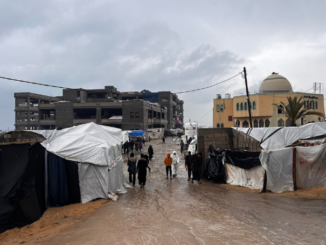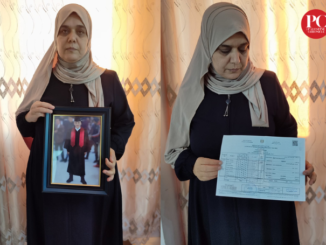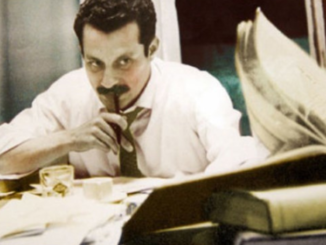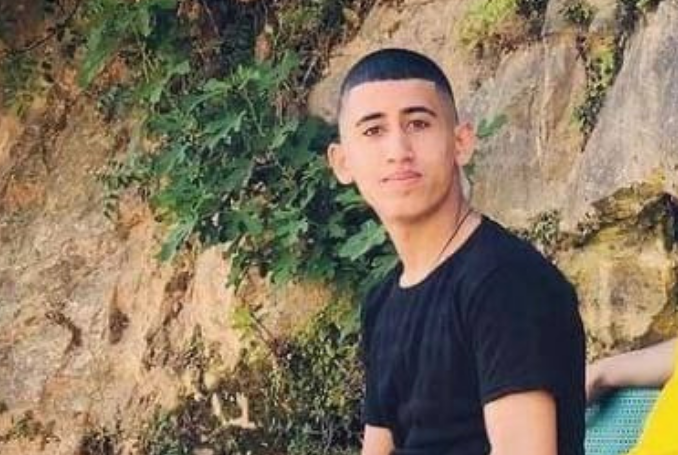
By David Harrop
Quasi Hamamra, a 16-year-old boy from the Bethlehem village of Husan, had been shot dead by an Israeli military soldier 4 days previously, and as such he was proclaimed a martyr by the local Palestinian community. Yet another fatality, whose life was lost in the continuing struggle against the Israeli occupation. 2022 has seen a significant rise so far in the deaths of young Palestinians at the hands of the Israeli military and from settlers who have been increasingly encouraged by their Israeli Prime Minister to take up arms against Palestinians. As a result, the streets and roads are increasingly dangerous places for Palestinian young men to be out in.
Husan village is up against the 8-meter-high wall and fences which are heavily protected by the Israeli military. As we drove into the village, standing in the shadows was a concrete outpost with three heavily armed soldiers, oppressive in their presence as they swapped images with each other on their cell phones as they monitored the cars and people passing.
Within Palestine, the occupation is a form of total control where the concept of “security” remains undefined. This means that the Israeli army remains unaccountable for its actions, and as such, no justice can be brought to bear on the situation. When a soldier kills a child, the narrative is one of necessary force in the light of “threats”. Children are castigated as “terrorists” and therefore can be “justifiably” killed by soldiers who are cast as defending their country, irrespective of whether this is rational, proportional, or necessary.
Once a child is deemed to be a “terrorist”, they become dehumanized and their human life cannot be valued either emotionally by the soldiers, or legally through the military-style courts. Hence, there is no recourse to justice for the family of the child who has been deliberately killed in his own street amongst his own community.
Nevertheless, any death represents an increased momentum to energize local resistance. Having a member of the community martyred galvanizes people to come together in a spirit of collective response, and hence it strengthens experiences of community identity. Anniversaries of martyrs’ deaths also represent occasions for people to come together as occasions of community solidarity. Such occasions continue to represent a powerful focus for the struggle for liberation.
Any response from the family and the community must be one of non-violence. In transforming their son to the status of a martyr, someone whose life and death are meaningful in the overall struggle against the occupation, his death achieves significance in the context of the struggle. Demonstrations in response to his death are statements of energy, defiance, and solidarity. When you have a heavily armed occupying militia and heavily armed settlers who hold strong anti-Arab views, non-accidental deaths and serious injuries are an inevitability, with male youth being particularly vulnerable.
Deaths and the days which follow bring people out of their houses and out onto the streets to sit together in solidarity with the bereaved family. This is in the spirit of shared community and where reactions, responses, and ideas are discussed collectively. Through shared grief, loss, and anger ideas are shared. Such incidents pull communities together in solidarity and increase the experiences of communal dialogue and collective identity.
In contrast to the foreboding Israeli fence and checkpoint, which stands in the shadows and darkness, the rest of the village appeared decorated in bright colorful fairy lights as the community was celebrating Ramadan.
It was during the holy month of Ramadan, and I had been invited to break the fast with my friend and his family. This was Iftar, the time after sundown when the fast can be broken and the streets are full of the wonderful smells of families cooking and preparing meals together. After sharing a meal, we traveled across Bethlehem to visit the family of the martyr.
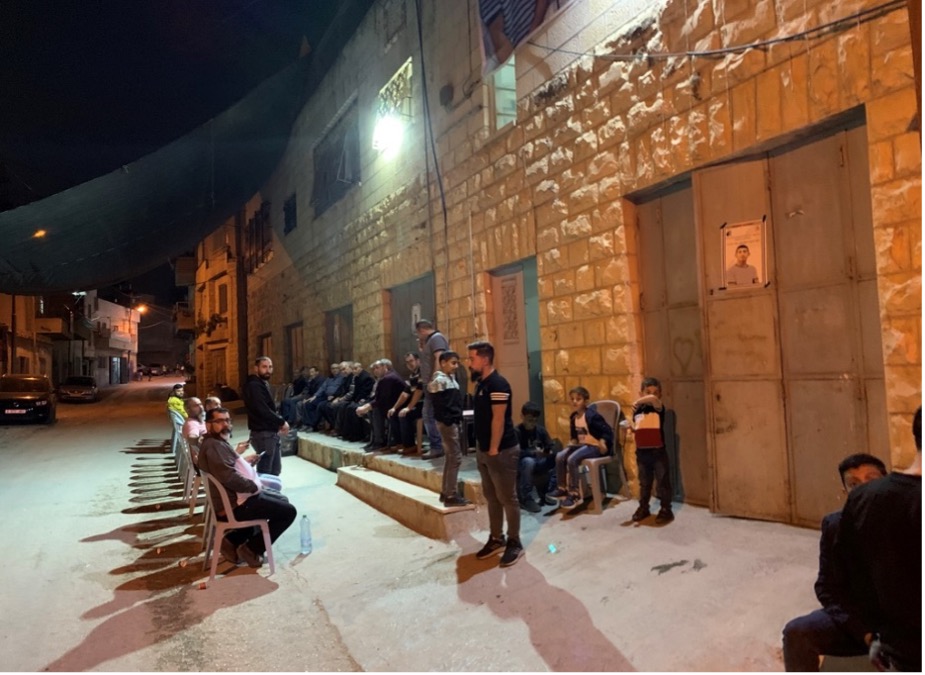
Pulling into a side street we easily saw the family house as there were two lines of chairs drawn up facing each other at the side of the road, where the men were sitting quietly together in support and in solidarity with the grieving family. Rudimentary lighting and fairy lights cast a glow over the scene, whilst posters of Quasi’s young teenager face adorned the walls of the street.
As a guest from the UK, I was invited upstairs to sit with the family and was ushered to sit down whilst one of Quasi’s friends plied us with shots of hot coffee. His parents explained how they were coping. They told me that their son’s ambition had been to train as a mechanic and how he wanted to be a skilled motor mechanic, hoping that at some point he could maybe have his own car.
He, like all young Palestinians, knew the risks involved in trying to live his daily life whilst under oppressive military occupation and he had friends and neighbors who had experienced violence and arrest. They live with the fear of injury and death and with resentment of being abused and threatened daily.
Amongst their families and communities, anger, grief, loss, and separation are fundamental features of life under violent occupation. Whilst there might be acts of bravado, many others have told me how they hold these issues internally and find themselves constantly reflecting on the stress and psychological burden of such fears.
Repeatedly, I have witnessed the hyper-vigilance and watchfulness of Palestinian children who are constantly alert for threats and risks. Undoubtedly this is corrosive to child development and serves to impede and restrict children from achieving their potential. Helping children to find a path through this frequently falls to social workers and educators who work directly with children, their families, and the community so as to help them find a path to resilience and coping.
Children were also present when Quasi was killed and undoubtedly will have been traumatized because of witnessing this violence. Thus, it seemed important that their inclusion in the grieving was an important aspect of their learning about their community solidarity.
Perhaps through the support of family, friends and community, his parents appeared to have found a means to be philosophical about the murder of their son. They told me that Quasi had talked to them about his vulnerability and his fears about his safety.
He had said how upset he was that he was forbidden to pray at the Al Aqsa Mosque in Jerusalem. Furthermore, he had told his parents that he hoped that if he were ever to become a martyr, he hoped that he might be allowed to die and ascend during the Holy month of Ramadan. Knowing this, his friends had constructed a picture of him against the Mosque with him rising to heaven. The family was eager to show me this and to be pictured with this.

Quasi lost his life as a part of the 74-year Palestinian struggle for its land, its people, and its right to self-determination. His death is part of the journey towards eventual liberation and genuine democracy, and his loss is a step in the journey towards inner strength and steadfastness against the abuse of a nation’s entitlement and rights for self-determination.
– David Harrop is an independent UK-registered social worker and co-founder of Palestine UK Social Work Network (PALUK) in 2011 under the aegis of the Global Development Agenda for Social Work (2010), which was launched by the International Federation for Social Work (IFSW). He contributed this article to The Palestine Chronicle.
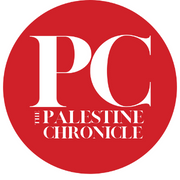
– David Harrop is an independent UK-registered social worker and co-founder of Palestine UK Social Work Network (PALUK) in 2011. Contact the author at his address email: harrop_david@yahoo.co.uk. He contributed this article to The Palestine Chronicle.

